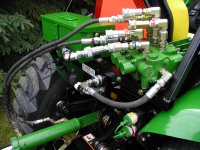AKKAMAAN
Veteran Member
Wayne County Hose,
Thanks, I learn something everyday. Did not know that.
AKKAMAAN ,
Are you saying that if that filter has a 25 psi bypass that the pump will cavitate before it reaches the bypass rate? If that is true, I don't think very many people know that.
Of course!
Pressure is a relative factor. In hydraulics we usually only talk about the pressure ABOVE atmospheric pressure. We can call it over-pressure!
So when measure the system pressure with a pressure gauge,

we let the oil pressure inside the Bourdon tube, and on the outside the tube, we have the atmospheric pressure.
When a pump "sucks" in the oil, it is technicly the atmospheric pressure that pushes the oil into the empty space that the pump creates on the inlet side when turning.
NO atmospheric pressure= NO oil into the pump.
(This a challenge for for aviation and space vessels, when they get on such high elevation so they loose the atmospheric pressure.)
And we all know that the atmospheric pressure varies between 14-15 psi, depending on weather, altitude etc?
When the pump turn around and creates this empty space on the inlet side, if this space dont gett filled it will become vacuum. 0 (zero) psi.
This filter on the inlet side will cause a pressure drop depending on size of flow. If filter is clogged, and the bypass is set to crack open at 15 psi or more, there will not be any oil going in to the pump. There will be vacuum only on the inlet side of pump. Cavitation???? Guess!!
The only reason to have a bypass set above atmospheric pressure, is to make it disabled.
We are used to return filter and they have made us accept 10-20 psi back pressure. If same size and gauge of filter is used on suction side it will cause the same pressure drop, 10-20 psi....Cavitation???Guess!!
This is the reason I am so curious about this desig with both strainer and suction filter on the pump inlet side. And of course even more comfused about the design when being told bypass open at 25 psi......

![DSCF1229 [R駸olution de l'馗ran]2.jpg](/forums/data/attachments/148/148927-6c0ef092d6ceed21162cf40c99719ad7.jpg)
![DSCF1230 [R駸olution de l'馗ran].JPG](/forums/data/attachments/136/136202-4034963d5444ccf62f94c3a236702abb.jpg)
![DSCF1233 [R駸olution de l'馗ran].JPG](/forums/data/attachments/148/148938-e992ceb00dd2224d25962ee87dc4c149.jpg)
